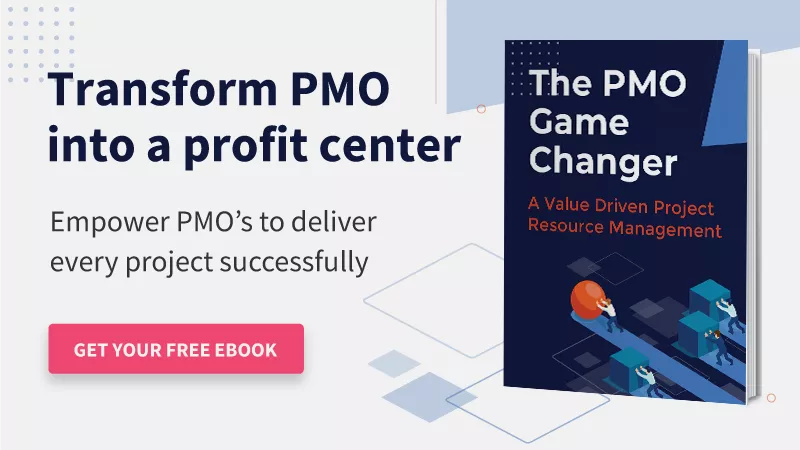The evolving market demand and increasing competition have led businesses to expand their horizons, invest in new projects, and build diverse portfolios. The purpose is to maximize the organization’s benefits from its investments in projects.
However, as the number of projects increases in the portfolio, it becomes challenging to monitor each of them and control every constraint such as budget, schedule, scope, and so on.
To combat this challenge, companies are now implementing a systematic framework to manage and execute their portfolio, known as project portfolio management.
PPM provides visibility of every project, its progress, and a high-level overview of resources’ productivity. In other words, it helps managers select, manage and execute profitable and strategically aligned projects while also catering to efficient resource planning. Given the benefits, developing an effective project portfolio management strategy is critical for enterprises.

This blog focuses on the significance and steps involved in project portfolio management.
Let’s get started:
What is project portfolio management (PPM)?
Project portfolio management (PPM) is the centralized process used by project managers and PMOs to manage one or more portfolios and achieve an organization’s strategic or long-term objectives.
According to PMI,
“PPM is the administration of one or more portfolios that bridge the gap between strategy and execution while improving overall efficiency.”
It enables managers to analyze the potential of various projects and formulate a plan to manage them. By following the PPM process, managers can consolidate the existing project data, forecast pipeline opportunities, and deploy the resource pool to the most valuable projects.
In a nutshell, an organization that implements project portfolio management centralizes the selection, prioritization, authorization, and management of projects and resources within a portfolio.
Read More: Understand 10 Benefits of an Effective Project Portfolio Management Strategy
Now that the definition is clear, let’s understand the fundamental difference between the three ‘P’s of project management below:
Portfolio VS. Program VS. Project
Here is an overview of the difference between these terminologies.
A project is a temporary and unique endeavor undertaken by a company or an organization to create a unique product or service. It has a definite time frame and comprises several tasks and sub-tasks to achieve a specific goal.
A program is a group of related projects managed together to achieve a common goal. All projects within a program cater to a unique product, service, or outcome.
A portfolio is a collection of several programs, individual projects, and other initiatives that may or may not be related to one another. However, they are all managed under one umbrella to achieve a strategic business objective. This includes improving profit margins, developing multiple similar products, etc.
Simply put, projects are grouped within more extensive programs that fit within larger portfolios.

By now, you must have understood the meaning and finer differences of the above terms. Now, let’s know the benefits that an organization can expect after implementing a definite Project Portfolio Management process:
Importance of project portfolio management
Within organizations, the resources are always limited, whether it’s people, space, financials, or equipment. Therefore, based on the organization’s mission and business requirements, PPM helps balance the portfolio such that appropriate projects and programs are selected, and the right resources are allocated for execution.
The other notable benefits of effective project portfolio management are:
- To begin with, it helps select and prioritize strategically aligned projects.
- Eliminates the low-profitable projects that are not adding any value to the portfolio.
- Enables managers to foresee risks involved at the portfolio and project level to form a mitigation plan ahead of time.
- Facilitates the allocation of resources to the most feasible and profitable projects across the enterprise.
- With a centralized view of every project under one portfolio, managers can easily track and monitor its progress and execution.
- Helps manage all the project interdependencies within a portfolio and mitigate resource-related risks.
- Moreover, PPM provides centralized information to keep every stakeholder or other decision-makers on the same page and minimize internal conflicts or discrepancies.
Read More: What is the Strategic Alignment of Portfolio, and Why is it Important?
The next pertinent question is, what exactly does a project portfolio manager do on a regular basis? Let’s look at their roles and responsibilities in detail here:
What are the roles & responsibilities of the Project Portfolio Manager?
As the name suggests, portfolio managers are the concerned people responsible for managing multiple programs and projects within a portfolio. They ensure that all programs under their respective portfolio are on track and align with the firm’s long-term goals.
They essentially work to supervise their portfolio’s progress, balance workforce capacity against demand and ensure competent resource allocation for seamless project execution. Since some project priorities are subject to change at any given time, portfolio managers need to monitor and evaluate all projects in regular cadence.
It may also be the case that managers find that some projects are underperforming during the execution of a project or program. In this scenario, a portfolio manager can either upgrade or reprioritize the programs and projects within a portfolio.
Furthermore, a large part of a portfolio manager’s job involves maintaining good relationships with stakeholders. They are responsible for reporting and informing the project’s status and performance to the stakeholders.
Besides this, portfolio managers are tasked with identifying change requests and prioritizing the most important ones based on their impact on the constraints and available resources. They are also in charge of assessing the risk in each project and implementing contingency plans if things go wrong.
Read More: 10 Must-have Project Management Skills for Successful Professionals
The functions outlined above are the core activities of a portfolio manager. Now, let’s talk about various steps involved in the PPM process:
What are the steps in project portfolio management?
The various steps of the PPM process help create a link between the overall business strategy, project selection, and project execution.
Here’s a list of the vital steps involved in this process:
Define project selection & prioritization criteria
As discussed earlier, the projects that a company groups together in one portfolio decide the firm’s profitability and help to achieve long-term business goals. Therefore, to succeed with project portfolio management, you should first define standard project selection criteria. It will help you undertake only profitable projects and contribute to the company’s mission in the long run.
After the projects are selected, prioritizing them will ascertain that the company’s resources and efforts are not wasted in futile endeavors.
Validate portfolio feasibility based on ROI
Once you have decided which projects to pursue, it’s crucial to assess their impact on the whole program and portfolio. The next step is to check its feasibility in terms of financial, human, and non-human resources. For that, you can consider the following questions:
- How does the project drive business goals?
- Is the project aligning with the program and portfolio?
- What is the project’s expected ROI?
- What resources do you need for the execution?
- What are the potential risks?
- Are there any resource constraints?
These pertinent questions will help to substantiate all the projects within a portfolio. For example, if three of your software development projects under one program will begin in April and you only have limited software developers, it will be a hindrance. Also, if two projects are interdependent, and a delay in one would cause a delay in the other, you might want to rethink starting them both simultaneously.
Form a resource plan for various projects in a portfolio
After the projects have been selected and prioritized, creating the right resource plan for each project within the portfolio is the next critical step. This will facilitate resource managers to deploy the workforce to the highest priority projects first, followed by the less-priority ones. In addition, it will help them make the best use of available resources and their expertise.
In case of any resource shortfalls, managers can look into the nature of the skillset required and the project duration and initiate retraining and upskilling programs. They can also hire a permanent/contingent workforce to fulfill the demand.
Read More: What is Resource Planning, and Why is it Important in Project Management?
Optimize resource schedules for better utilization
To achieve optimum productivity and ensure timely project delivery, optimizing a resource’s schedule is essential. Depending upon the timeline, project managers can create an appropriate resource schedule. If a niche resource is allocated to two or more projects within the portfolio, they can consider implementing optimization techniques.
For instance, they can implement the resource-leveling technique and adjust the project timeline as per the critical resource’s capacity. Or else, enforce smoothing techniques to pull in more resources and balance the workload or redistribute the tasks while staying on schedule. Additionally, even during the execution, project managers can keep track of schedule with forecast vs. actual utilization and understand if the project is progressing as planned, and there is no shift in the timeline.
Monitor & control project portfolio
Once the projects are initiated, the onus is on portfolio managers to regularly track projects‘ progress and check if any significant issues have emerged. For example, if the project manager notices an increase in costs or a delay in meeting milestones, they should intervene and take corrective actions to get the project back on track.
Monitoring the portfolio will include the following:
- Provide expert assistance and audit the project delivery mechanisms.
- Coordinate with project managers to monitor the performance of projects
- Track the milestones progress and completion regularly.
- Identify and resolve conflicts between project managers.
- Make changes to the portfolio as needed, including putting projects on hold, canceling, and adding new projects.
- Ensuring projects are progressing without any shift in strategic alignment.
- Monitor and track the project and portfolio budget accurately so that things don’t go out of hand.
Streamline change requests from clients
Every project is subject to change at any given point. It can be additional client requirements, or modifications in the current phases, etc. Thus, it is crucial to analyze any change requests before implementing them during the project’s course. For instance, if a client requests impromptu revisions to a current project, then the project team is required to do additional tasks. Therefore, it will require more effort from the team’s end, escalate project costs, and even lead to timeline delays.
To regulate this without causing scope creep, managers can formulate a change management strategy. It lays out the actions that must be followed when a client requests a modification. Thus, the onus lies with the change control board to examine and review all the changes suggested by clients. And once approved and deemed feasible by CCB, then only it is incorporated into the execution.
Implement a risk management plan
Developing an organizational risk management strategy is vital for mitigating uncertainty within the project portfolio and ensuring success. Managers can conduct risk assessments before and throughout a project’s lifecycle to evaluate each project’s inherent and potential risks. It enables them to take corrective actions in a timely manner and keep the stakeholders up-to-date on any changes.
This helps businesses be proactive to combat issues such as loss of employee productivity, shortage of resources, skill gaps, unplanned absences, or retirement and mitigate them effectively.
Read More: How to Mitigate Resource Risk in Project Management?
By following these steps, managers can implement a resource management solution to ensure maximum productivity and successful project delivery. The following section explains how a resource management solution can become a significant game-changer in streamlining the PPM process:
How can resource management software help streamline project portfolio management process?
An advanced resource management solution provides unmatched visibility into the resource attributes such as skills, location, experience, availability, utilization, etc. Thus, using an advanced filter, resource managers can allocate the best available resources to suitable projects at the right cost.
The forecasting and capacity planning solution provides foresight into resource demand across various portfolios. Based on this, managers can forward plan pipeline projects and implement the right resourcing treatments to bridge the gap. The tool also gives you real-time insight into the resource metrics such as availability, utilization heatmaps, capacity vs. demand, project vacancy and people on the bench, forecast vs. actual, etc. This is particularly helpful in a multi-project environment as the managers can view all the data-driven insights, stay forewarned of issues, and take corrective actions before the project or portfolio is derailed.
Read More: Project Portfolio Management- How Resource Capacity Planning can be a Game-Changer
Conclusion
Project Portfolio Management is fundamental to a business’s success and growth. It has a much broader scope than traditional project management, which primarily focuses on delivering individual projects within a deadline, budget, and scope.
PPM helps create a strategic plan, make informed decisions, centralize demand management, schedule, and manage all resources and projects successfully, thereby driving more profitability and efficiency.
The Glossary
Read More: Glossary of Resource Workforce Planning, Scheduling and Management
The SAVIOM Solution
SAVIOM is the market leader in offering the most powerful and configurable solutions for managing enterprise resources efficiently and effectively. Having more than 20 years of experience, this Australian-based MNC has a global presence in over 50 countries. It is also popular with more than 100 customers and helps them achieve their business goals. SAVIOM also has products for project portfolio management, professional service automation, and workforce planning software which can be easily customized as per business requirements.










